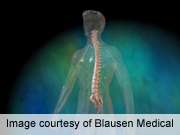Spinal disorders that trigger early retirement have a significant impact on labor force participation and the gross domestic product in Australia, according to a study published online Oct. 22 in The Spine Journal.
(HealthDay)—Spinal disorders that trigger early retirement have a significant impact on labor force participation and the gross domestic product (GDP) in Australia, according to a study published online Oct. 22 in The Spine Journal.
To quantify the personal cost of lost income and cost to the state of early retirement because of spinal disorders in Australians aged 45 to 64 years, Deborah J. Schofield, Ph.D., from the University of Sydney in Australia, and colleagues analyzed a microsimulation model built on data from the Australian Bureau of Statistics' Survey of Disability, Ageing, and Carers and an income and savings microsimulation model.
The researchers found that, compared with 45- to 64-year-olds in full employment with no health conditions, those who retired early because of spinal disorders had significantly lower income (79 percent less), paid significantly less taxation (100 percent less), and received significantly more in government support payments (21,000 percent more). The median total weekly income of those who retired early because of spinal disorders was AU$310, compared with a value four times that for those who were employed full time. The aggregate impact on labor force participation resulted in AU$4.8 billion lost in annual individual earnings; AU$622 million paid in additional welfare payments; AU$497 million lost in taxation revenue; and AU$2.9 billion in lost GDP.
"Although the individual has to bear the economic costs of lost income in addition to the burden of the condition itself, the state experiences the impacts of loss of productivity from reduced workforce participation, lost income taxation revenue, and increasing government support payments," the authors write.
More information:
Abstract
Full Text (subscription or payment may be required)
Journal information: Spine Journal
Copyright © 2012 HealthDay. All rights reserved.


















